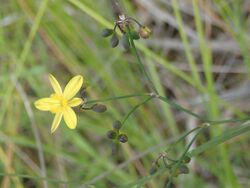Biology:Tricoryne elatior
| Tricoryne elatior | |
|---|---|

| |

| |
| Scientific classification Error creating thumbnail: Unable to save thumbnail to destination
| |
| Kingdom: | Plantae |
| Clade: | Tracheophytes |
| Clade: | Angiosperms |
| Clade: | Monocots |
| Order: | Asparagales |
| Family: | Asphodelaceae |
| Subfamily: | Hemerocallidoideae |
| Genus: | Tricoryne |
| Species: | T. elatior
|
| Binomial name | |
| Tricoryne elatior | |
| Synonyms[3] | |
|
Tricoryne elatior var. decipiens Domin | |
Tricoryne elatior (common name yellow autumn-lily, yellow rush-lily)[4] is a species of flowering plant in the family Asphodelaceae, native to Australia,[3] and found in all its states and territories.[4]
Description
Tricoryne elatior is a rhizomatous perennial herb, with fibrous roots,[5] It grows to a height of 10-40 cm but sometimes grows to 1 m.[6] The leaves are linear, 5–10 cm by 1–3.5 mm wide, and usually glabrous. The flowering axis is terete, and has a smooth surface although sometimes there are scabrous hairs at the axis base. The umbels carry 2–10 flowers on pedicels which are about 1.5–6 mm long. The outer tepals are oblong, acute, three-veined, and 6–14 mm by 1.5–3 mm, while the inner tepals are elliptic, obtuse, three-veined, and 5–10 mm by 3–4 mm wide.[6] The tepals twist spirally after flowering and later fall.[5] There are six stamens which are attached to the base of the perianth.[5] The filaments are 3–6 mm long[6] with tufts of clavate hairs below the anthers[5] (which are ovate, and 0.6–0.9 mm long).[6] The mericarps are ellipsoidal, and 3–6 mm by 1.5–3.5 mm and slightly reticulate.[6]
Habitat
It is found in sclerophyll forests, in heaths and woodlands, and sometimes in swamps, growing on sandy loams and lateritic soils.[6][4]
References
- ↑ "Tricoryne elatior". Australian Plant Name Index (APNI), IBIS database. Centre for Plant Biodiversity Research, Australian Government. https://biodiversity.org.au/nsl/services/rest/name/apni/97062.
- ↑ Brown, R. (1810). "Tricoryne". Prodromus florae Novae Hollandiae et insulae Van-Diemen, exhibens characteres plantarum quas annis 1802-1805. p. 278. https://www.biodiversitylibrary.org/page/2954434. Retrieved 2020-03-12.
- ↑ 3.0 3.1 "Tricoryne elatior R.Br. | Plants of the World Online | Kew Science". http://powo.science.kew.org/taxon/urn:lsid:ipni.org:names:542461-1.
- ↑ 4.0 4.1 4.2 Thongpukdee, A. (2020). "Tricoryne elatior in Flora of Australia". Australian Biological Resources Study, Department of Agriculture, Water and the Environment, Canberra. https://profiles.ala.org.au/opus/foa/profile/Tricoryne+elatior.
- ↑ 5.0 5.1 5.2 5.3 "Tricoryne (PlantNET - FloraOnline)". http://plantnet.rbgsyd.nsw.gov.au/cgi-bin/NSWfl.pl?page=nswfl&lvl=gn&name=Tricoryne.
- ↑ 6.0 6.1 6.2 6.3 6.4 6.5 "Tricoryne elatior (PlantNET - FloraOnline)". http://plantnet.rbgsyd.nsw.gov.au/cgi-bin/NSWfl.pl?page=nswfl&lvl=sp&name=Tricoryne~elatior.
External links
Wikidata ☰ Q15604370 entry
 |

